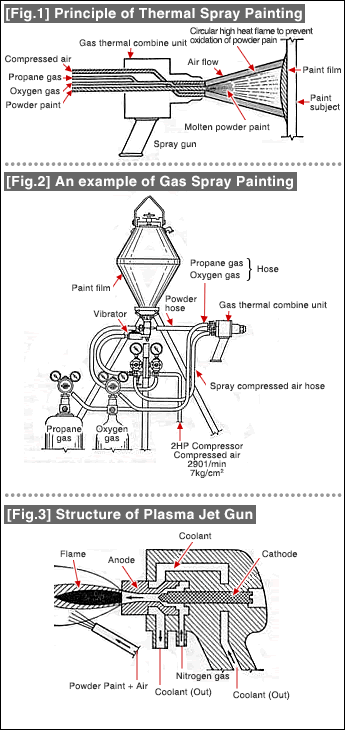| The thermal spray method of powder painting evolved from thermal spraying of metal powder, and the method is often used with thermoplastic resin paints such as polyethylene and nylon. For thermosetting resin paints such as epoxy and etc., the films need to be reheated to re-melt after thermally spraying. For the thermal spraying systems, there are Gas Spraying system, Plasma Jet Spraying system, and etc. The Gas Spraying system on [Fig.1], device structure on [Fig.2], a Plasma Jet Gun structure is shown on [Fig.3]. With the gas spraying system, high temperature flames of 2,000〜3,000°C by combustion of oxygen and acetylene gas (or propane gas) is generated. Compressed air is sprayed enveloping the flame to adjust for the length of the flame while preventing oxidation of the powder paint. The powder paint is injected in the center of the flame to melt, or semi-melt to be sprayed onto the workpiece. Normally, the workpieces are preheated to 100〜200°C in order to improve paint adhesion, as well as the surface is seared to smooth the paint film. With this method, paint baking furnace is not needed, enabling painting of large structures, outdoor objects, thick coating on interior walls of large chemical equipment. With Plasma Jet Spraying, as shown on [Fig.3], an arc is generated by applying a DC current between a cathode and an anode in the gun. When inert gas is introduced into this arc, the gas is ionized and the plasma is generated by the heat of the arc. When the ionized gas is cooled by the gas around the arc and the coolant, the electrons, proton ions and atoms reversibly bond and a type of thermal reaction generates heat of 20,000°C or more. There is an application example, DC50〜75v/130〜150A, nitrogen gas of 50~70L/minute, coolant 15~20L/Minute, epoxy powder paint of 30~60g/Minute. |  |
May 2014 Archives
The electrostatic painting is a type of atomized coating where the paint particles are atomized with centrifugal, pneumatic, hydraulic forces, and static electricity charged to electrically coat the workpieces.
As well known, the static electricity is generated on the surface of glass rods when the rods are rubbed with silk cloths and furs alike. The silk rubbed glass rods would be charged positively (+), and the fur rubbed glass rods are charged negatively (-).
The positively charged objects are attracted to the negatively charged objects, but the positive and positive, or negative and negative charges will repel each other. As shown on [Fig.1], when the workpiece to be painted is grounded and the paint atomizing device is charged negatively at high voltage, the workpiece would be positively charged and they form an electrostatic field. The paint particles negatively charged exiting the atomizing device would then be attracted and coat the workpiece. Feature of this method is that it wastes almost no paint as compared to hand-held spray guns.
![[Fig.1] Conceptual diagram of electrostatic painting system](http://www.misumi-techcentral.com/tt/en/surface/images/184_1.gif)
Industrially used electrostatic painting devices are broadly classified on [Table 1]. There are paint spray devices that are fixed stationary types, conveyor applicable types that move over some distances, and hand-held types that can be used in various ways by operators similar to the conventional hand-held spray guns.
[Table 1] Classification of electrostatic painting devices
|
